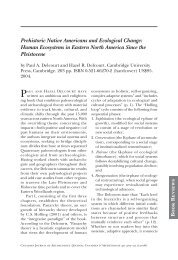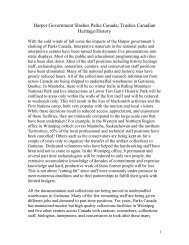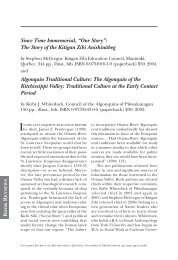(1): numéro de l'atelier / session number Abel, Tim - Canadian ...
(1): numéro de l'atelier / session number Abel, Tim - Canadian ...
(1): numéro de l'atelier / session number Abel, Tim - Canadian ...
- No tags were found...
You also want an ePaper? Increase the reach of your titles
YUMPU automatically turns print PDFs into web optimized ePapers that Google loves.
interpretation of the site, as well as the nearby lighthouse station on île aux Perroquets.The remains are believed to be associated with the wreck of the Cly<strong>de</strong>, a transatlanticsteamer stran<strong>de</strong>d and lost on île du Wreck in 1857.Daly, Aoife (University College, London) Oak in Northern Europe (13) Viking ships inroyal burials, barrel staves discar<strong>de</strong>d on a smithy floor, panels as the support for paintingsby the Dutch Masters, beams in the roofs of cathedrals, planks lining a latrine. Amultitu<strong>de</strong> of contexts: all linked by oak. Through precise chronology and i<strong>de</strong>ntification oforigin, a history of tra<strong>de</strong> links and timber resource exploitation throughout NorthernEurope, over time, can be told. Dendrochronological study of oak in the region, over thelast 50 years or so, has resulted in the accumulation of an enormous tree-ring dataset. Thegenerous sharing of data between scholars has allowed links between a wi<strong>de</strong> diversity ofmaterial contexts. Tree-rings are the key to the nature of Northern Europe’s forest and it’sexploitation by humans, to the balance between regions with surplus and those withshortage, to connections between regions and to mechanisms of tra<strong>de</strong>, both of timberobjects and of timber as a raw material.Damkjar, Eric and Joan (Archaeological Survey of Alberta) A Tale of TwoLonghouses: Archaeological Vignettes from the South and the North (23) This papertouches on two of Peter Rams<strong>de</strong>n’s favorite research areas – <strong>de</strong>aling with sites we had theprivilege to investigate with Peter. In the Upper Trent Valley of Southern Ontario, theCoulter site is a late 16 th century Iroquoian village that saw continued expansion at a timewhen the St. Lawrence Iroquois were experiencing great <strong>de</strong>mographic disruption – eventsthat may be reflected in the small but growing amounts of St. Lawrence Iroquois potteryat Coulter. An unusual artifact from Coulter may provi<strong>de</strong> a more tangible link with the St.Lawrence River Valley – what we believe to be a “pottery <strong>de</strong>corator” ma<strong>de</strong> from seamammal bone. During two field seasons exploring the archaeological terra incognita ofPrince of Wales Island, Nunavut, we were struck by the paucity of Late Dorset sites – butthere was one. We will draw a tentative connection between the non-<strong>de</strong>script Wicklowsite and Late Dorset Longhouses.Danek 1,4 , Malgorzata, André Robichaud 2 , Colin P. Laroque 3 and TrevorBell 1 Developing a regional eastern larch (Larix larcinia) chronology for the Maritimes(13) 1 Department of Geography, Memorial University of Newfoundland and Labrador, St.John’s, NL. 2 Secteur <strong>de</strong>s Arts et <strong>de</strong>s sciences humaines (géographie et gestion intégrée<strong>de</strong>s zones côtières), Université <strong>de</strong> Moncton, campus <strong>de</strong> Shippagan, Shippagan, NB, E8S1P6. 3 Mount Allison Dendrochronology Laboratory, Department of Geography, MountAllison University, Sackville, NB, E4L 1A7. 4 Faculty of Geology, Geophysics andEnvironment Protection, AGH-University of Science and Technology, Krakow, Poland.Eastern larch (Larix larcinia) is one of the species commonly found in historical buildingsin the Maritimes, especially those associated with shipyard structures. Determining theabsolute age of larch structural elements from the 1800s is hin<strong>de</strong>red by the lack of a longlivedregional master chronology. Today, the tree is only found in bogs, and when located,it is usually un<strong>de</strong>r 100-years old. This research <strong>de</strong>scribes how the MAD Lab sought out a<strong>number</strong> of long-lived larch chronologies from living trees, and exten<strong>de</strong>d the regionalchronology back in time by adding wood from structures. In this case study, we will








